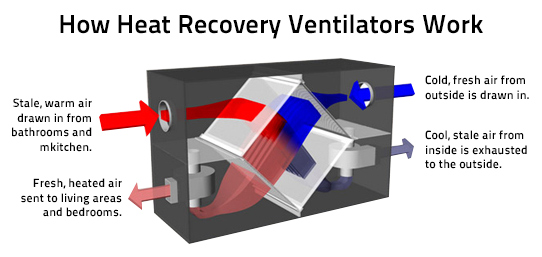The All-Inclusive Guide to the Uses of Heat Recovery Ventilation in Modern Buildings
Heat Recovery Ventilation (HRV) systems represent a significant improvement in developing innovation (HRV Heat Recovery Ventilation). They supply a technique for trading stale indoor air with fresh outdoor air while minimizing power loss. This technique not only improves interior air high quality however likewise adds to energy effectiveness in both domestic and commercial buildings. Understanding the different applications and advantages of HRV can reveal its essential duty in modern-day layout and sustainability initiatives. The implications of this innovation deserve discovering better
Understanding Heat Recovery Ventilation Solutions

Lots of contemporary buildings focus on energy performance, comprehending warmth healing air flow (HRV) systems is important for maximizing interior air top quality and lowering power consumption. HRV systems work by transferring warmth from stagnant interior air to incoming fresh air, properly preserving comfy indoor temperature levels while minimizing power loss. These systems contain a heat exchanger, followers, and ductwork that assist in the flow of air. Throughout winter season, HRV units record and recycle warm from the outgoing air, while in summer season, they can assist cool incoming air. By continually exchanging air, HRV systems also lower moisture and the focus of indoor contaminants. Appropriate installation and upkeep of HRV systems are important for their effectiveness and performance in improving overall building performance and convenience.
Benefits of Heat Recovery Ventilation
Heat recovery ventilation systems provide various benefits that enhance both power efficiency and indoor air quality in contemporary buildings. By capturing and reusing energy from exhaust air, these systems significantly reduce heating and air conditioning costs, bring about reduced power intake. Furthermore, they preserve a consistent flow of fresh exterior air, reducing the risk of indoor air toxins and allergens. This continual exchange aids regulate humidity degrees, avoiding mold development and making certain a healthier living setting. Additionally, HRV systems add to sustainability objectives by lowering general carbon footprints. Their capability to optimize ventilation without giving up thermal convenience makes them a valuable enhancement to contemporary structure layout, advertising both economic and environmental advantages.
Applications of HRV in Residential Structures
As homeowners progressively focus on energy effectiveness and interior air high quality, the applications of heat recovery ventilation (HRV) systems in residential buildings have become much more common. HRV systems are especially beneficial in firmly secured homes, where keeping fresh air blood circulation is vital for preventing dampness build-up and indoor pollutants. They properly move warmth from outgoing stagnant air to incoming fresh air, lowering power costs connected with cooling and heating. Additionally, HRVs can boost comfort degrees by managing humidity and temperature. They are likewise versatile for various residential layouts, consisting of single-family homes and multi-unit buildings. In general, integrating HRV systems supports lasting living techniques while ensuring a much healthier interior environment for owners.
HRV in Business and Industrial Setups
In business and commercial settings, the implementation of warmth recuperation ventilation (HRV) systems has ended up being increasingly essential for optimizing energy performance and preserving air top quality. These systems efficiently move warmth from exhaust air to incoming fresh air, minimizing the need for added heating or cooling. This not only reduces energy costs but additionally adds to sustainability efforts. Industries such as manufacturing, warehousing, and office complex profit substantially from HRV systems, as they aid control temperature and humidity degrees, making certain a comfy and efficient atmosphere. HRV systems aid in getting rid of impurities and excess wetness, enhancing interior air high quality. As policies around air top quality end up being stricter, the fostering Website of HRV technology is most likely to grow, making it a critical element of modern industrial and industrial infrastructure.
Future Fads in Heat Recovery Ventilation Innovation

Frequently Asked Concerns
Just How Does Heat Recovery Ventilation Impact Indoor Air Quality?
Heat recovery ventilation considerably improves interior air top quality by constantly trading stagnant interior air with fresh outside air while recovering energy. This procedure minimizes contaminants, preserves perfect moisture degrees, and assures a much healthier environment for residents.
Can HRV Systems Be Mounted in Existing Structures?
HRV systems can undoubtedly be installed in existing structures. Retrofitting may require alterations to ductwork and air flow formats, but it significantly improves power efficiency and interior air top quality, making it a practical alternative for older frameworks.
What Maintenance Is Needed for HRV Systems?

Exist Details Climates Where HRV Is Much More Reliable?
Heat recovery ventilation systems are specifically reliable in environments with considerable temperature level differences between periods. These systems maximize energy efficiency by recouping warm from exhaust air, making them perfect for both cool and moderately cozy atmospheres.
Exactly How Do HRV Systems Affect Power Bills?
